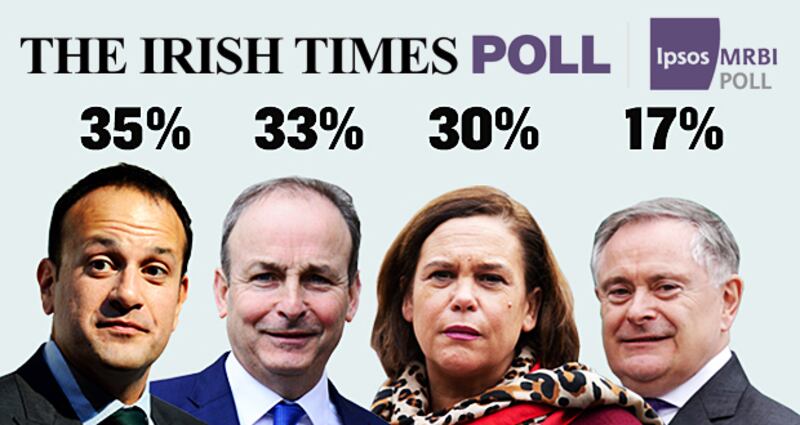One week down, 2½ to go – and it's all to play for. But winning a third term in government will be very much an uphill battle for Fine Gael, which is facing challenges from Fianna Fáil, from the Green Party – and from a resurgent Sinn Féin.
The first campaign poll for The Irish Times by Ipsos MRBI will calm nerves in Fine Gael after a weekend poll had the party a massive 12 points behind Fianna Fáil. But it also shows the extent to which Fine Gael support has fallen before the election – right at the time that the party needed it to increase.
The six-point drop that Fine Gael sees in its numbers – compared to our last poll in October – is bigger than anything the party has seen in this series since the last general election. And the cratering of Taoiseach Leo Varadkar’s personal rating – down from 51 per cent to 35 per cent – will alarm the party which has designed much of its campaign around its leader.
It’s hard to escape the fact that Fine Gael has been confronted with its own unpopularity – a revelation which is always uncomfortable, no matter how predictable, for governments. Better now than on polling day, Varadkar might say, but it does show the extent of the challenge facing him and his colleagues.
Just over a quarter of people say they are satisfied with the way the Government is running the country. Impossible to win on those sort of numbers. Varadkar’s task now is not just to outline a positive and compelling vision of the future but to overcome the negativity with which many voters now view his party and the Government he has led for 2½ years. The Taoiseach needs to change some minds if he is to win.
Having difficulty
It is clear that Fine Gael is having difficulty dealing with the fact that it no longer dominates the media debate about politics – its opponents have a much greater share of airtime and column inches than they usually do. The net result is that it is harder for Fine Gael to get its message out, and when it does, it is highly contested.
The result of all that is that these numbers show Fianna Fáil is now in a stronger position to be the largest party in the next Dáil, and therefore in a strong position to form the next government. Support for the party has gradually recovered in Dublin (it’s now at 20 per cent) where the party needs to win new seats but is also strong among farmers (36 per cent), which will worry Fine Gael.
One other potentially important factor in interpreting these numbers for Fianna Fáil is that the party has tended to do better in recent elections than its opinion poll scores. If that pattern repeats itself, and combined with a strong ground game in the constituencies, the party is on course for significant – and perhaps decisive – seat gains.

But if Fianna Fáil will be satisfied with the poll numbers, Sinn Féin will be delighted. After a difficult two years since Mary Lou McDonald became party president – punctuated by poor election results – the latest numbers suggest Sinn Féin could retain all its Dáil seats and win some new ones.
However, the party leadership is unlikely to be complacent – one of the most well-established of recent Irish electoral trends is that Sinn Féin has failed to live up to pre-election polls when the votes are counted. Part of the explanation for this is the party is strongest among those voters who are statistically least likely to turn out – and the latest numbers show again its strongest support among younger voters and working-class voters. But for all that, these numbers make happy reading for Sinn Féiners.
Partial comeback
Not so happy for Labour, nor for independents and smaller parties. Labour is at 5 per cent nationally (though 8 in Dublin), about half the level that the party has historically traded at. A partial comeback for the party is possible – but only if it comes through in key target constituencies such as Dublin Bay North and Louth.
The scatter of smaller parties and groups – the Social Democrats, Solidarity-People Before Profit, Independents4Change, the Independent Alliance – are all showing little change, bouncing around under the margin of error.
The Green Party, by contrast, has separated itself from the rest of the pack and at 8 per cent – 15 per cent in Dublin - it can realistically hope for a significant breakthrough. If it can add to these numbers in the next three weeks, and get those votes in the right places, the party stands on the verge of a historic election, and probable participation in the next government.













